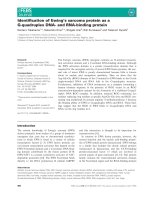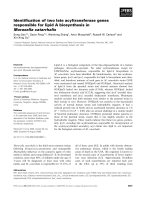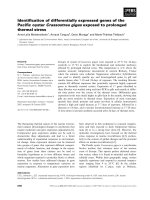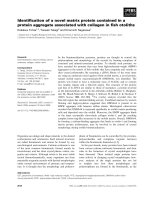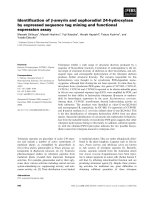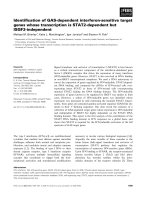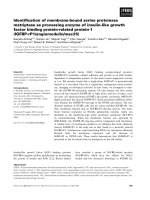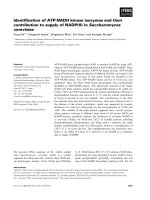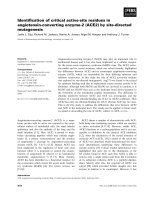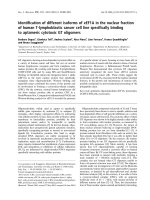Báo cáo khoa học: Identification of NF1 as a silencer protein of the human adenine nucleotide translocase-2 gene pptx
Bạn đang xem bản rút gọn của tài liệu. Xem và tải ngay bản đầy đủ của tài liệu tại đây (293.15 KB, 8 trang )
Identification of NF1 as a silencer protein of the human adenine
nucleotide translocase-2 gene
Peter Barath
1,2
, Daniela Poliakova
1,2
, Katarina Luciakova
1,2
and B. Dean Nelson
1
1
Department of Biochemistry and Biophysics, Arrhenius Laboratories, Stockholm University, Sweden;
2
Cancer Research Institute,
Slovak Academy of Sciences, Bratislava, Slovak Republic
The human adenine nucleotide translocase-2 (ANT2) pro-
moter contains a silencer region that confers partial repres-
sion on the heterologous herpes simplex virus thymidine
kinase (HSVtk) promoter [Barath, P., Albert-Fournier, B.,
Luciakova, K., Nelson, B.D. (1999) J. Biol. Chem. 274,
3378–3384]. Two sequences in the silencer (Site-2 and Site-3)
are protected in the DNase I assay in vitro, and one of these
is a repeated GTCCTG element previously shown to act as
the active repressor element. We have now purified the DNA
binding protein, and identified it using MALDI-TOF MS
as a 33-kDa member of the nuclear factor 1 (NF1) family of
transcription factors. NF1 purified from rat liver and HeLa
cell nuclei bind to both silencer Site-2 and Site-3, resulting in
a DNase I footprint identical to that obtained with purified
recombinant NF1. Furthermore, transient transfection
experiments with reporter constructs containing mutated
silencer Site-2 and/or Site-3 show that both sites contribute
to repression of the HSVtk promoter. Finally, chromatin
immunoprecipitation analysis reveals that NF1 is bound
to both elements on the endogenous HeLa cell ANT2
promoter. Our data support the belief that NF1 acts as a
repressor when bound to silencing Site-2 and Site-3 of the
ANT2 gene.
Keywords: adenine nucleotide translocase; NF1; promoter
regulation; silencer protein; transcription.
Two major isoforms of the adenine nucleotide translocase
(ANT) are expressed in mammalian cells. Both catalyse the
exchange of mitochondrial ATP for cytosolic ADP, thereby
playing key roles in maintaining the cytosolic phosphory-
lation potential, adenylate charge, and the energy status
of the cell. The two forms, ANT1 and ANT2 [1–4], are
differentially expressed in mammalian tissue. ANT1 is
expressed predominately in heart and skeletal muscle [5,6]
whereas ANT2 is more widely expressed [5,7,8]. ANT2
is strongly growth regulated [9,10], and expression of the
gene is downregulated in growth arrested cells [10] and
re-activated in cells entering the G
1
growth phase. Activa-
tion of ANT2 expression is mediated at the level of
transcription [10].
To understand ANT2 expression, we have undertaken
a study of its promoter. Constitutive ANT2 expression is
maintained by two synergistically interacting Sp1 elements
(the AB boxes) in the proximal promoter [11]. However,
activation via the AB box Sp1 is modulated by three
separate repressor regions. One of these is an Sp1 binding
element (C box) juxtaposed to the transcriptional start site,
which, when occupied, decreases ANT2 expression several-
fold [11]. Repression appears to involve a direct interaction
between Sp1 bound to the AB and C boxes [12]. A second
repressor region, that is responsible for ANT2 down
regulation in growth-arrested cells, has recently been
identified in the distal promoter [10]. This region contains
two DNA elements, Go-1 and Go-2, that bind nuclear
factor 1 (NF1) in growth-arrested cells, but not in growth-
activated cells [13]. NF1 binding is associated with growth
arrest repression of ANT2 transcription.
A third repressor (silencer) region, which does not
participate in growth arrest repression of the gene [13],
but confers repression on a heterologous herpes simplex
virus thymidine kinase (HSVtk) reporter gene, has also
been located in the ANT2 promoter between the AB
activation boxes and the Go repressor region [14]. Two
DNA sequences in the silencer region (Site-2 and Site-3)
are strongly protected in the DNase I assay. One of these
(Site-2) is a repeated element (GTCCTG) shown to have a
role in repressing the HSVtk promoter [14]. In the present
study, we have purified the silencer element binding
protein, and identified it as a member of the NF1 family
of proteins (see [15] for review). NF1 binds to Site-2 and
Site-3 both in vitro and in vivo, and repression of the
heterologous HSVtk promoter is relieved by mutating
either element. Thus, NF1 plays a major role in regulating
ANT2 expression by modulating (repressing) the efficiency
with which Sp1 functions as a constitutive activator.
Correspondence to K. Luciakova, Cancer Research Institute, Slovak
Academy of Sciences, Vlarska 7, 833 91 Bratislava, Slovak Republic.
Fax: + 421 259327250, Tel.: + 421 259327110,
E-mail:
Abbreviations: ANT, adenine nucleotide translocase; NF1, nuclear
factor 1; CAT, chloramphenicol acetyl transferase; HSVtk, herpes
simplex virus thymidine kinase; wt, wild-type; mut, mutant;
Site-2 and Site-3, NF1 binding elements 2 and 3 in the
silencer region; Go-1 and Go-2, Go NF1-binding repressor
elements 1 and 2.
Note: P. Barath and D. Poliakova contributed equally to this work.
(Received 5 December 2003, revised 5 March 2004,
accepted 15 March 2004)
Eur. J. Biochem. 271, 1781–1788 (2004) Ó FEBS 2004 doi:10.1111/j.1432-1033.2004.04090.x
Materials and methods
Plasmid preparation
ANT2 promoter fragments ()374/)235) bearing the wild-
type (wt) or mutated Site-3 ()374/)347) elements were
prepared by PCR using the wt or mutated Site-3 element
(5¢-GGGTTCTTTT
TAAATCCCTGTAGC-3¢, underlined
nucleotides represent mutation of the wt, GGC, sequence)
as the 5¢ primer. The M13 reverse primer from HSVtk-
chloramphenicol acetyltranferase (CAT) [16] was used as
the 3¢ primer. Template DNAs [HSVtk-CAT-ANT2 ()413/
)235)] carrying the wt or the mutated Site-2 element were
described previously [14]. PCR was performed with Vent
DNA polymerase (BioLabs) according to the manufacturer.
Amplified DNA containing the wt and/or mutated Site-2
and Site-3 were digested with BglII and ligated into HSVtk-
CAT plasmid. All clones were checked for fragment size
and orientation by digestion with restriction enzymes, and
mutations were verified by sequencing.
A DNase I footprint probe containing Site-2, 3 and Go-2
elements was made by adding XbaI sites to both ends of
ANT2 )825/)795 [13]. This oligonucleotide, which includes
Go-2, was ligated into the XbaI site of the pCAT-ANT2
()546/)235)wt [14]. The clones were checked by restriction
enzyme digestion and sequencing.
Cell culture and transfection
Growth and transfection of HeLa cells experiments were
performed as by Li et al. [11]. Five micrograms of reporter
plasmid DNA containing the CAT gene and 2 lg of control
luciferase plasmid DNA (pGL3, Promega) were used for
transfection. CAT and luciferase activities were measured as
described [17].
DNase I protection assay
Rat liver and HeLa nuclear extracts were prepared as
described previously [18,19]. The DNase I protection assay
was performed as described [17]. Radioactive probes were
prepared by PCR using 5¢ [
32
P]-labelled CAT primer, the
M13 primer and pCAT-ANT2-()546/)235)wt [14] or
pCAT-Go-2-ANT2()546/)235)wt [13] as the template.
Electrophoretic mobility shift (EMSA) and supershift
assay
EMSA analyses were performed as by Li et al.[11]. For
supershift experiments, 2 lL of antibody raised against
human NF1-C (rabbit polyclonal antiserum, 8199, kindly
provided by N. Tanese, New York University Medical
Center, NY, USA) were added to the binding reaction and
incubated on ice for a further 15 min. Complexes were
separated on 4% nondenaturing polyacrylamide gel. The
gels were dried and autoradiographed. Competitor DNAs
used in EMSA analysis were: NF1 wt, 5¢-TTTTG
GATTGAAGCCAATATGATA-3¢;NF1mut,5¢-TTTT
GGATTGAATAAAATATGATA-3¢;Site-2wt,5¢-GCGT
CTCACCCTAGTCCTGGTCCTGCTCCAAGGGTTTT
TGTCC-3¢;Site-2mut,5¢-GCGTCTCACCCTAGTAA
TGGTAATGCTCCAAGGGTTTTTGTCC-3¢;Site-3wt,
5¢-GGGTTCTTTTGGCATCCCTGTAGC-3¢;Site-3mut,
5¢-GGGTTCTTTTTAAATCCCTGTAGC-3¢.
Chromatin immunoprecipitation
Chromatin immunoprecipitation of NF1 from exponenti-
ally growing HeLa cells was performed as described
previously [13]. Immunoprecipitation was performed
with either 2 lL of antiserum 8199 prepared against a
central domain of the NF1 C protein (kindly provided by
N. Tanese) or 2 lL of antirat liver b-F
1
ATPase (unrelated
protein). Amplification of immunoprecipitated DNA frag-
ments (2 lL) was performed using the primer set: )525
(5¢-TGACCTTGTCTCGTTGCCTCACCC-3¢)and)378
(5¢-GCTACAGGGATGCCAAAAGAACCC-3¢)forthe
Site-3, and primer set )346 (5¢-GCGTCTCACCCTAGT
CCTGGTCCTGC-3¢)and)214 (5¢-GGAAGGGGCGGG
TCCAGAGAACA-3¢) for the Site-2 element. PCR was
performed for 32 cycles with 30 s of denaturation at 94 °C,
followed by 30 s of annealing at 60 °C and 30 s of extension
at 72 °C. The last step included extension for 10 min at
72 °C.
NF1 purification from nuclear extracts
Rat liver nuclei were purified as described by Kadonaga
[20]. Nuclei from HeLa cells were prepared according to
Dignam et al. [18]. Proteins were extracted from nuclei by
addition of an equal volume of extraction buffer (20 m
M
Hepes pH 7.9, 820 m
M
NaCl, 5 m
M
MgCl
2
,1m
M
EDTA,
1m
M
EGTA, 0.5 m
M
phenylmethanesulfonyl fluoride,
1m
M
benzamidin, 0.5 m
M
dithiothreitol). The various
fractionation steps are described by Luciakova et al. [13].
Site-2 and Site-3 binding activity in all fractions was
monitored by the in vitro DNase I protection assay. The
DNA affinity column, used as the last step in the
purification, was prepared with an oligonucleotide contain-
ing either the Site-2 and Site-3 elements (nucleotides )404/
)240) or the Go-2 element (nucleotides )825/)792, [13]).
The columns were prepared according to Kadonaga [20].
Proteins were eluted in two salt steps (200 m
M
and 500 m
M
NaCl) in 20 m
M
Hepes pH 7.9, 5 m
M
MgCl
2
,5m
M
2-mercaptoethanol, 5% glycerol, 0.1% Nonidet P-40.
Protein fractions were stored at )70 °C.
Size exclusion chromatography was carried out on
samples fractions from the Heparin Sepharose XK 16/20
column that contained Site-2/Site-3 DNase I footprinting
activity (see above). A Superdex 200 HR 10/30 column
(Amersham Biosciences) equilibrated in elution buffer
(20 m
M
Hepes pH 7.9, 420 m
M
NaCl, 5 m
M
MgCl
2
)was
loaded with 0.25 mL of sample. The column was eluted at
0.1 mLÆmin
)1
. Fractions of 0.5 mL were collected after the
void volume of the column.
SDS/PAGE and protein identification by MALDI-TOF MS
Samples from the DNA affinity column were precipitated
for 20 min on ice in 10% trichloroacetic acid, followed by a
15 min centrifugation at 10 000 g and two washes with ice-
cold acetone. Samples were air dried, dissolved in sample
buffer, and separated in 10% SDS/PAGE. Proteins were
visualized by silver staining and bands of interest were cut
1782 P. Barath et al. (Eur. J. Biochem. 271) Ó FEBS 2004
out. In-gel tryptic digestion and sample preparation was
carried out as described by Luciakova et al.[13].MALDI-
TOF analysis was performed in reflector mode using a
Voyager-DE STR MALDI-TOF mass spectrometer
(Applied Biosystems). Internal calibration was performed
with autodigested trypsin. Data were analysed using
MOVERZ
software (Proteometrics, LLC, Winnipeg, Canada),
and database searches were done with
MASCOT
(http://
www.matrixscience.com).
Results
Purification and identification of the silencer binding
proteins
The promoter of the human ANT2 gene contains three
repressor regions (see Fig. 1A for a summary). The silencer
region between nucleotides )412 and )235, has been
characterized and shown by DNase I protection to include
three protein binding sites [14], two of which (Sites-2 and -3,
Fig. 1A and B) are consistently and strongly protected
in vitro. To identify the Site-2 and Site-3 binding proteins,
they were purified from rat liver nuclei using the )404/)240
ANT2 fragment (termed Site-2/Site-3 oligonucleotide) as a
DNA affinity probe. Purification was monitored using the
DNase I assay. As seen in Fig. 2, proteins that protect Sites
2 and 3 from DNase I coelute from both the Resource Q
(Fig. 2A) and the DNA affinity (Fig. 2B) columns. DNA
affinity is the last step in the purification scheme. Foot-
printing activity is eluted from the DNA affinity column
only in fractions 1 and 2 of the low salt (200 m
M
NaCl) wash
(Fig. 2B). SDS/PAGE analysis revealed the presence of
several polypeptides in fractions 1 and 2 (Fig. 2C). How-
ever, only one, with an apparent mass of around 33 kDa, is
found specifically in the active fractions (Fig. 2B). All other
polypeptides in low salt fractions 1 and 2 are also present in
inactive fractions eluted with 500 m
M
salt.
The 33-kDa polypeptide (marked with a dot in Fig. 2C)
was identified as a member of the NF1 family of transcrip-
tion factors [15] by trypsin fragment mass analysis using
MALDI-TOF MS. Out of 13 peptide masses, nine (69%)
were matched to different isoforms of NF1 from different
species covering up to 58% of the total protein sequence. The
matched peptides originate from a conserved, 240-residue
N-terminal DNA binding domain [21] (Fig. 2D), thus
excluding the possibility of determining the specific isoform
of NF1 (for review see [15]) involved. No other transcription
factors were detected in the purified preparations.
Identification of a 33 kDa NF1 polypeptide is consistent
with our earlier studies in which a 33–38 kDa silencer-
binding protein was suggested based on crosslinking and
South-western analysis with HeLa cell nuclear extracts [14].
However, gel filtration of the rat liver Heparin Sepharose
fraction shows that Site-2/Site-3 binding activity (33 kDa
NF1) is present only in fractions 12 and 13 (Fig. 3A) which
contain polypeptides of a greater mass. These data suggest
that the Site-2/Site-3 binding protein exists as a complex,
most likely as a dimer.
Proteins that bind the Site-2/Site-3 elements and the
upstream growth arrest (Go) elements copurify. NF1
also binds two upstream growth arrest elements (Go-1 and
Go-2) in the ANT2 promoter [13]. To determine if the
Site-2/Site-3 and Go-element binding activities are identical,
we constructed a DNAse I protection probe that included
both the Go-2 and the Site-2/Site-3 elements (see Methods).
As seen in Fig. 3A, Site-2/Site-3 and Go-2 binding proteins
comigrate during gel filtration, suggesting that the same or
similar proteins bind to both sets of elements. As a further
test, Go element binding-proteins were purified from rat
liver nuclei by DNA affinity chromatography, and tested in
the DNase I protection assay (Fig. 3B). Identical footprints
were obtained on the Site-2/Site-3 elements using proteins
purified from the Go- or the Site-2/Site-3 affinity columns.
These data support the notion that NF1 footprints both the
Go and Site-2/Site-3 elements. However, the affinity of NF1
for the Site-2/Site-3 elements is lower than for the Go
element, as indicated by elution from the Site-2/Site-3
affinity column in low (200 m
M
) salt, whereas elution of
footprinting activity from the Go affinity column requires
500 m
M
NaCl (Fig. 3B).
Purified recombinant NF1 binds to the Site-2/Site-3
elements. To obtain further proof that NF1 is the Site-2/
Site-3 binding protein, DNase I protection analysis was
carried out using purified recombinant human NF1. As
anticipated, recombinant NF1 protected both Site-2 and
Site-3 (Fig. 4A). Furthermore, the pattern of protected and
Fig. 1. Summary of the human ANT2 promoter region. (A) Repressor
elements in the Sp1 C box, the silencer region (Site-2/Site-3), and Go
regions of the human ANT2 promoter are shown in grey. The two Sp1
AB box activation elements are shown as open symbols. (B) DNA
sequence of the silencer region (nucleotides )413/)235) of the human
ANT2 gene. Data are from Barath et al. [14]. Lines above the
sequences mark the Site-1, Site-2, and Site-3 regions footprinted in the
in vitro DNase I protection assay. The arrows in Site-2 indicate a
repeated hexanucleotide (GTCCTG) element identified as an active
repressor element [14]. The arrow in the Site-3 indicates a NF1 protein-
binding half site described in the present study. The mutations intro-
duced into the Site-2 and Site-3 elements are indicated above the
sequence.
Ó FEBS 2004 NF1 is the silencer protein of ANT2 (Eur. J. Biochem. 271) 1783
hypersensitive sites produced by recombinant NF1 are
similar, if not identical, to those observed with rat liver
nuclear extracts (Figs 2 and 3A), affinity purified NF1 from
rat liver (Figs 2B and 3B and [13]) and HeLa nuclear
extracts [14]. NF1 did not footprint Site 1 [14] of the silencer
region, which is also present in the probe used in Fig. 4A.
Fig. 2. Purification and identification of the silencer Site-2 and Site-3 binding-protein. Rat liver nuclear extracts were purified as described. (A)
Fractions eluted from Heparin Sepharose in a 100 m
M
to 300 m
M
NaCl linear gradient, or (B) fractions eluted from the DNA affinity column in 200
or 500 m
M
NaCl were monitored for DNase I protection activity using the ANT2–546/)235 silencer region as a probe. Activity was also
determined in samples loaded onto the affinity column (S) and in flow through (F) fractions. Location of Site-2 and Site-3 elements are indicated on
the right. Asterisks mark hypersensitive sites, open circles mark protected nucleotides. (C) SDS/PAGE analysis of polypeptide eluted from the
DNA affinity column. The dot beside lane 1 indicates the polypeptide band identified as NF1 by MALDI-TOF MS. (D) Peptide mass alignment.
Sequences in bold match the trypsin fragment masses from the SDS band in (C).
1784 P. Barath et al. (Eur. J. Biochem. 271) Ó FEBS 2004
A direct DNase I protection analysis comparing HeLa cell
nuclear extract, DNA-affinity purified proteins from HeLa
cells and purified recombinant human NF1 show the same
pattern of protected nucleotides (Fig. 4B), thus confirming
that NF1 binds to the silencer elements.
EMSA also showed that oligonucleotides bearing Site-2
and Site-3 elements inhibit binding of HeLa nuclear extract
proteins to a bipartite consensus NF1 element (Fig. 4C), but
less efficiently than the consensus NF1 element itself.
Purified recombinant NF1 exhibit the same specific binding
as the HeLa nuclear extract proteins. Supershift experiments
confirm the identity of NF1 as the factor bound to Site-2/
Site-3 (Fig. 4C).
In vivo
occupation of Site-2 and Site-3 as revealed
by chromatin immunoprecipitation (ChIP) analysis
To determine if Site-2 and Site-3 are occupied in vivo,ChIP
analysis was carried out on HeLa cells (Fig. 5). Both
elements are occupied by NF1 in vivo (Fig. 5) as detected
by EtBr staining of amplified products. Together, the above
experiments demonstrate clearly that NF1 is the Site-2 and
Site-3 binding protein.
Site-2 and Site-3 both contribute to repression of the ANT
promoter. Deleting the Site-2/Site-3 silencer elements
eliminates repression of the HSVtk promoter in
transfected HeLa cells [14]. To study the roles of Site-2
and Site-3 individually, they were mutated and placed in
front of the HSVtk promoter. These constructs were
transfected into HeLa cells. Fig. 6 shows that promoter
activity is increased approximately threefold when both sites
are mutated, but appear to be only partially activated when
the elements are mutated individually. Thus, it seems likely
both elements participate in repression.
Discussion
We earlier reported the presence of a silencer region in the
human ANT2 promoter that conferred repression on the
heterologous HSVtk promoter [14]. Three protein-binding
sites were found by in vitro DNase I footprinting, one of
which contained a GTCCTG repeat required for repres-
sion. A 33–38 kDa DNA binding protein was purified
using the GTCCTG element (silencer Site-2) as an affinity
probe. In the present study, we identify the GTCCTG
binding protein as a member of the NF1 family of
transcription factors. We also show that NF1 binds to a
second silencer element (Site-3, Fig. 1) upstream of the
GTCCTG repeat, and that both elements contribute to
repression of the HSVtk promoter. Furthermore, NF1
occupies both silencer elements in HeLa cells in vivo,
implicating NF1 as a possible repressor even under
endogenous conditions.
The NF1 polypeptide identified in the present experi-
ments exhibits a mass of 33 kDa, which is slightly less
than that reported in our previous study [14], but fits well
with the mass of the protein that cross-linked to the
GTCCTG element [14]. We also reported the copurifica-
tion of p33 together with a 49-kDa polypeptide [14]. p49
appeared not to bind DNA, but was loosely associated
with p33, perhaps enhancing p33 binding [14]. Using the
present purification scheme for the Site-2/Site-3 binding
proteins, which is substantially modified from that used in
[14], p49 does not appear as a major polypeptide in the
purified fractions. This result is consistent with the loose
association to p33 observed earlier. However, partially
purified Site-2/Site-3 binding activity (NF1) moves on a
gel filtration column with an apparent molecular mass
greater than 33 kDa, suggesting that it exists as a
complex, and most likely as a dimer.
Fig. 3. The Site-2 and Site-3 silencer
elements and the Go-2 repressor binding
proteins cofractionate. (A) Rat liver nuclear
extracts were fractionated on a Heparin
Sepharose column. Eluted fractions (1–19)
were monitored by the DNase I assay using a
probe engineered to include both the Site-2
and Site-3 silencer elements and the Go-2
repressor element. Asterisks and open circles
mark hypersensitive and protection nucleo-
tides, respectively. (B) Rat liver nuclear
proteins were purified from a DNA affinity
column containing the Go-2 element as a
binding matrix [13] (Materials and methods).
Site-2, Site-3, and Go-2 elements are indicated
on the right. Asterisks denote hypersensitive
and open circles protected nucleotides.
Ó FEBS 2004 NF1 is the silencer protein of ANT2 (Eur. J. Biochem. 271) 1785
Repression of the HSVtk promoter via the silencer region
is partially relieved by mutating Site-2 or Site-3, suggesting
that NF1 bound to these elements cooperate in some
manner. NF1 binding to Site-2 and Site-3 is not co-
operative, because Site-3 remains protected in the DNase I
assay when Site-2 is mutated [14]. Thus, repression most
probably requires a concerted action between NF1s bound
to the two sites, or with a third component. The possibility
of an additional component is consistent with our observa-
tions concerning p49 (see above). However, this issue
remains to be resolved. In any event, the results of ChIP
analysis demonstrating the in vivo occupation of Site-2 and
Site-3 by NF1 strongly suggest that these interactions are of
physiological relevance.
Fig. 4. Identification of the Site-2 and Site-3
binding protein as a member of the NF1 family
of transcription factors. (A) Binding of
purified, recombinant NF1 to the Site-2 and
Site-3 elements was monitored by the DNase I
protection assay of ANT2 oligonucleotide
()546/)235). Only the coding strand is shown.
Competitor oligonucleotides contained either
a wt or mutated (mut) Site-2, Site-3 or NF1
element. Asterisks denote hypersensitive
nucleotides, open circles denote protected
nucleotides. (B) Proteins from HeLa cells and
purified recombinant NF1 protect the same
nucleotides in the ANT2 silencer region.
Asterisks denote hypersensitive nucleotides
and open circles denote protected nucleotides
in the Site-2/Site-3 region. (C) EMSA and
supershift analysis was performed with 10 lg
of HeLa nuclear extract or with purified
recombinant NF1 (as indicated) and the
32
P-labelled oligonucleotide probe containing
a NF1 bipartite consensus binding sequence
(probe NF1 wt, Santa Cruz Biotechnology).
Wild-type (wt) or mutated (mut) competitor
oligonucleotides were added. The NF1
element was added in 50-fold excess, and
oligonucleotides containing the Site-2 ()339/
)310) or Site-3 element ()374/)347) were
added in 100-fold excess. Samples in lanes
marked with Ab NF1 were incubated with
antibody 8199 (Materials and methods).
Preimmune serum was used as a control for
supershift experiments. The major shifted
complexismarkedbyanarrow.Freeprobeis
seen near the bottom of the gel.
1786 P. Barath et al. (Eur. J. Biochem. 271) Ó FEBS 2004
The NF1 family of proteins plays a wide role in
replication of several viral DNAs and in transcription of
many cellular genes. A significant role for NF1 proteins
in regulating the growth state, hormonal induction and
repression and oncogenic processes has been also described
(see [15] for review). The NF1 family is composed of four
genes, NF1-A, -B, -C and -X (see [15] for review), and a
large number of splice variants of each gene [22–24]. Most
expressed isoforms contain a highly conserved 240-residue,
N-terminal DNA binding domain. Because our identifica-
tion of NF1 by MALDI-TOF MS is based primarily on
peptide mass matches within the conserved DNA binding
domain, we cannot distinguish between the various
isoforms. Furthermore, NF1 exist in the cell as homodimers
or heterodimers [25], and the large number of possible
dimers that can be formed complicate identification of the
active species on any particular promoter.
Several isoforms of NF1 can act as transcription repres-
sors [26–30], and in some cases repressor domains have been
located within the protein [30,31]. Furthermore, repression/
activation by individual NF1 isoforms can also depend on
cell context [13,30–32], suggesting that the molecular action
of NF1 depends on cell-specific factors. Indeed, a variety of
factors is reported to interact directly with NF1; including
coactivators p300/CBP and SRC-1 [33], histone H3 [34] and
the general transcription factor Sp1 [35], TFIIB [36], and
TAFII155 [37]. Thus, the molecular mechanisms of NF1
repression on ANT2 remain to be elucidated.
The physiological role of the Site-2/Site-3 repressor
elements remains to be investigated. Deletion of these
elements has no apparent influence on growth-arrest
repression of ANT2 exerted via the Go-2/Go-3 growth-
arrest elements [13]. Thus, we speculate that NF1 bound to
Site-2/Site-3 elements most probably has a role in adjusting
the tissue-specific constitutive expression of ANT2, similar
to that proposed for the unique Sp1 repressor element
(C box) juxtaposed to transcription start [11].
Acknowledgements
This study was supported by the Swedish Research Council (to B. D.
N.), the Slovak Science and Technology Assistance Agency (APVT)
Grant 26-002102 and the Slovak Grant Agency (VEGA) 2/3087/23 (to
K. L.). The authors thank O
¨
. Wrange for recombinant human NF1 and
N. Tanese for the generous gift of antihuman NF1-C serum.
References
1. Neckelmann, N., Li, K., Wade, R.P., Shuster, R. & Wallace, D.C.
(1987) cDNA sequence of a human skeletal muscle ADP/ATP
translocator: Lack of a leader peptode, divergence from a fibro-
blast translocator cDNA, and coevolution with mitochondrial
DNA genes. Proc.NatlAcad.Sci.USA84, 7580–7584.
2. Houldsworth, J. & Attardi, G. (1988) Two disctinct genes for
ADP/ATP translocase are expressed at the mRNA level in adult
human liver. Proc. Natl Acad. Sci. USA 85, 377–381.
3. Cozens, A.L., Runswick, M.J. & Walker, J.E. (1989) DNA
sequences of two expressed nuclear genes for human mitochon-
drial ADP/ATP translocase. J. Mol. Biol. 206, 261–280.
4. Ku, D H., Kagan, J., Chen, S T., Chang, C D., Baserga, R. &
Wurzel, J. (1990) The human fibroblast adenine nucleotide
translocator gene. Molecular cloning and sequencing. J. Biol.
Chem. 265, 16060–16063.
5. Stepien, G., Torroni, A., Chung, A.B., Hodge, J.A. & Wallace,
D.C. (1992) Differential expression of adenine nucleotide trans-
locator isoforms in mammalian tissues and during muscle cell
differentiation. J. Biol. Chem. 267, 14592–14597.
6. Lunardi, J., Hurko, O., Engel, W.K. & Attardi, G. (1992) The
multiple ADP/ATP translocase genes are differentially expressed
during human muscle development. J. Biol. Chem. 267, 15267–
15270.
7. Do
¨
rner, A., Pauschinger, M., Badorff, A., Noutsias, M., Giessen,
S., Schulze, K., Bilger, J., Rauch, U. & Schultheiss, H P. (1997)
Tissue-specific transcription pattern of the adenine nucleotide
translocase isoforms in humans. FEBS Lett. 414, 258–262.
8. Du
¨
mmler, K., Mu
¨
ller, S. & Seitz, H.J. (1996) Regulation of
adenine nucleotide translocase and glycerol 3-phosphate
Fig. 6. Site-2 and Site-3 elements act in a concerted manner to cause the
repression of ANT2 promoter. Transient transfections analysis of the
heterologous )374/)235 ANT2 promoter constructs bearing combi-
nation of the wt (open boxes) or mutated (crossed boxes) Site-2 ()339/
)310) and Site-3 ()374/)347) elements. Promoter fragments were
cloned in front of the HSVtk promoter and transfected into HeLa cells.
CAT activity was normalized for transfection efficiency. The values of
the activities are set relative to the activity of the clone carrying wt
Site-2 and Site-3 elements. The results represent the mean
value ± S.E. of five independent experiments in which each experi-
mental point was determined in triplicate.
Fig. 5. The Site 2 and Site 3 silencer elements are occupied by NF1
in vivo. ChIP was carried out on formaldehyde-crosslinked HeLa cells.
Exponentially growing cells were crosslinked with 0.25% formalde-
hyde. Chromatin was isolated and specific DNA–protein complexes
were immunoprecipitated with no antibody (lanes 2 and 7), or with
anti-NF1 8199 (lanes 4 and 9), or with unrelated antibodies (lanes 3
and 8). After reversal of the crosslink, DNA was amplified by PCR
using the specific primers: Site-3, primer set )525/)378; Site-2, primer
set )346/)214. Total chromatin (lanes 5 and 10), and no DNA (lanes 1
and 6) were used as positive and negative PCR controls. As a marker
(lane M), the 100-bp gene ruler (Fermentas) was used.
Ó FEBS 2004 NF1 is the silencer protein of ANT2 (Eur. J. Biochem. 271) 1787
dehydrogenase expression by thyroid hormones in different rat
tissues. Biochem. J. 317, 913–918.
9. Battini, R., Ferrari, S., Kaczmarek, L., Calabretta, B., Chen, S T.
& Baserga, R. (1987) Molecular cloning of a cDNA for a human
ADP/ATP carrier which is growth-regulated. J. Biol. Chem. 262,
4355–4359.
10. Barath,P.,Luciakova,K.,Hodny,Z.,Li,R.&Nelson,B.D.
(1999) The growth-dependent expression of the adenine nucleo-
tide translocase-2 (ANT2) gene is regulated at the level of tran-
scription and is a marker of cell proliferation. Exp. Cell Res. 248,
583–588.
11. Li, R., Hodny, Z., Luciakova, K., Barath, P. & Nelson, B.D.
(1996) Sp1 activates and inhibits transcription from separate ele-
ments in the proximal promoter of the human adenine nucleotide
translocase 2 (ANT2) gene. J. Biol. Chem. 271, 18925–18930.
12. Zaid, A., Hodny, Z., Li, R. & Nelson, B.D. (2001) Sp1 acts as a
repressor of the human adenine nucleotide translocator-2 (ANT2)
gene. Eur. J. Biochem. 268, 5497–5503.
13. Luciakova, K., Barath, P., Poliakova, D., Persson, A. & Nelson,
B.D. (2003) Repression of the human ANT2 gene in growth-
arrested human diploid cells: The role of nuclear factor 1 (NF1).
J. Biol. Chem. 278, 30624–30633.
14. Barath, P., Albert-Fournier, B., Luciakova, K. & Nelson, B.D.
(1999) Characterization of a silencer element and purification of a
silencer protein that negatively regulates the human adenine
nucleotide translocator 2 promoter. J. Biol. Chem. 274, 3378–3384.
15. Gronostajski, R.M. (2000) Roles of the NFI/CTF gene family in
transcription and development. Gene 249, 31–45.
16. Luckow,B.&Schu
¨
tz, G. (1987) CAT constructions with multiple
unique restriction sites for the functional analysis of eucaryotic
promoters and regulatory elements. Nucleic Acids Res. 15, 5490.
17. Promega (1991) Promega Protocols and Applications Guide. 2nd
edition. Madison, WI.
18. Dignam, J.D., Lebovitz, R.M. & Roeder, R.G. (1983) Accurate
transcription initiation by RNA polymerase II in a soluble extract
from isolated mammalian nuclei. Nucleic Acids Res. 11, 1475–
1489.
19. Blobel, G. & Potter, V.R. (1966) Nuclei from rat liver: isolation
method that combines purity with high yield. Science 154, 1662–
1665 issn: 0036–8075.
20. Kadonaga, J.T. (1991) Purification of sequence-specific binding
proteins by DNA affinity chromatography. Methods Enzymol.
208, 10–23.
21. Gounari, F., De Francesco, R., Schmitt, J., van der Vliet, P.,
Cortese, R. & Stunnenberg, H. (1990) Amino-terminal domain of
NF1 binds to DNA as a dimer and activates adenovirus DNA
replication. EMBO J. 9, 559–566.
22. Santoro, C., Mermod, N., Andrews, P. & Tjian, R. (1988) A
family of human CCAAT/box/binding proteins active in tran-
scription and DNA replication: cloning and expression of multiple
cDNAs. Nature 334, 218–224.
23. Rupp,R.,Kruse,U.,Multhaup,G.,Gobel,U.,Beyreuther,K.&
Sippel, A. (1990) Chicken NF1/TGGCA proteins are encoded by
at least three independent genes: NFI-A, NFI-B, and NFI-C with
homologues in mammalian genomes. Nucleic Acids Res. 18,
2607–2616.
24. Kruse, U. & Sippel, A.E. (1994) The genes for transcription factor
nuclear factor I give rise to corresponding splice variants between
vertebrate species. J. Mol Biol. 238, 860–865.
25. Kruse, U. & Sippel, A.E. (1994) Transcription factor nuclear
factor I proteins form stable homo- and heterodimers. FEBS Lett.
348, 46–50.
26. Adams, A.D., Choate, D.M. & Thompson, M.A. (1995) NF1-L is
the DNA-binding component of the protein complex at the
peripherin negative regulatory element. J. Biol. Chem. 270, 6975–
6983.
27. Osada, S., Daimon, S., Ikeda, T., Nishihara, T., Yano, K.,
Yamasaki, M. & Imagawa, M. (1997) Nuclear factor 1 family
proteins bind to the silencer element in the rat glutathione trans-
ferase P gene. J. Biochem. (Tokyo) 121, 355–363.
28. Szabo, P., Moitra, J., Rencendorj, A., Rakhely, G., Rauch, T. &
Kiss, I. (1995) Identification of a nuclear factor-I family protein-
binding site in the silencer region of the cartilage matrix protein
gene. J. Biol. Chem. 270, 10212–10221.
29. Liu, Y., Bernard, H.U. & Apt, D. (1997) NFI-B3, a novel tran-
scriptional repressor of the nuclear factor I family, is generated by
alternative RNA processing. J. Biol. Chem. 272, 10739–10745.
30. Gao, B. & Kunos, G. (1998) Cell type-specific transcriptional
activation and suppression of the alpha1B adrenergic receptor
gene middle promoter by nuclear factor 1. J. Biol. Chem. 273,
31784–31787.
31. Osada, S., Ikeda, T., Xu, M., Nishihara, T. & Imagawa, M. (1997)
Identification of the transcriptional repression domain of nuclear
factor 1-A. Biochem. Biophys. Res. Commun. 238, 744–747.
32. Apt, D., Liu, Y. & Bernard, H.U. (1994) Cloning and functional
analysis of spliced isoforms of human nuclear factor I–X: inter-
ference with transcriptional activation by NFI/CTF in a cell-type
specific manner. Nucl. Acids Res. 22, 3825–3833.
33. Chaudhry, A.Z., Vitullo, A.D. & Gronostajski, R.M. (1999)
NuclearfactorI-mediatedrepressionofthemousemammary
tumor virus promoter is abrogated by the coactivators p300/CBP
and SRC-1. J. Biol. Chem. 274, 7072–7081.
34. Alevizopoulos, A., Dusserre, Y., Tsai-Pflugfelder, M., von der
Weid, T., Wahli, W. & Mermod, N. (1995) A proline-rich TGF-
beta-responsive transcriptional activator interacts with histone
H3. Genes Dev. 9, 3051–3066.
35. Rafty, L.A., Santiago, F.S. & Khachigian, L.M. (2002) NF1/X
represses PDGF A-chain transcription by interacting with Sp1
and antagonizing Sp1 occupancy of the promoter. EMBO J. 21,
334–343.
36. Kim, T.K. & Roeder, R.G. (1994) Proline-rich activator CTF1
targets the TFIIB assembly step during transcriptional activation.
Proc.NatlAcad.Sci.USA91, 4170–4174.
37. Tanese, N., Pugh, B.F. & Tjian, R. (1991) Coactivators for a
proline-rich activator purified from the mutlisubunit human
TFIID complex. Genes Dev. 5, 2212–2224.
1788 P. Barath et al. (Eur. J. Biochem. 271) Ó FEBS 2004
